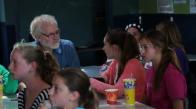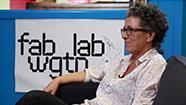Kimi Whiting shares how tertiary study has changed her thinking around identity.
Cultural appropriation and identity
Transcript
So in my cultural background I have Māori and Indonesian roots. Within that, there are a lot of art and design, specialities, you could say. Ranging from artists, to architects, to conservators. My whole family is really into design.
Last year I took two papers that were called "Communication in Creative Cultures" and "Conversations in Creative Cultures".Through these papers we covered ideology, capitalism, nationalism, identity, and biculturalism.
Design is for people. It's for everyone to share and engage in. So cultural appropriation plays a huge part in that. Just because it's people's cultures you're talking about and it's not something to be taken as lightly as they think, (some designers think). Making sure that you represent and understand the cultures before you put them into your work is a major part of being a designer nowadays. Just because you don't want to offend anybody. You also want to be able to put the best image of that culture out there – and use it in a way that's going to make the culture more authentic and more celebrated rather than degrading it, in a way.
So, just making sure that designers understand where things can be placed and whether or not they can be mass produced because you're representing that culture.
Identity of my generation has changed quite a lot – social platforming has become quite a big part of our lives. It's become embedded in our day to day plans. Your identity can change on social platforms all the time – from gaming to how you send a message (like emojis or like making yourself into an avatar). There is more room, or more platforms, for people to change who they are and who they want to be, or aspire to be.
You can put on any image you want and people won't know any different as social platforming is almost like a mask for a real person. You don't know who the person is until you really meet them but people use it because it's fun.
You're just playing a game. But it's not – you're becoming someone else that is doing things that are not in the social norm. As emojis you’re sending little pictures to represent how you feel. English, grammar, everything out the window you're just sending a little kissy face or a tree instead of actually writing so that changes your identity in a way that you can't express how you feel through words but through little cartoon imagery.
Through Massey University and all the papers that I have taken I've been thinking about identity in a very different way to what I would have thought at high school. Through the papers we understand how the world works, and how society works, and how communities work. It influences your design immensely. As a designer, a learning designer, we understand more about how our designs not only affect us, but also the communities. It's not about aesthetics sometimes it also about functionality, quality, and purpose and how it can effectively change your surroundings in a positive way.
Related videos
A year 13 student talks about her career pathways (00:55)
A student shares about combining her interests in law and food technology.
Building relationships with students visiting a technology centre (03:05)
Steve Jeffares and Brenda Whycherley show that building strong relationships develops confidence for their students.
What’s happening at the Fab Lab (02:04)
Wendy Nealle describes the Fab Academy qualification and how digital fabrication – makerspaces and hackerspaces – opens up opportunities for students....



